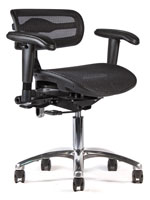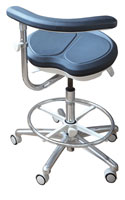
Prevent Pain with the Right Operator Stool
Selecting a seating option that supports a neutral spine and promotes comfort will help dental hygienists reduce the ergonomic risks faced in clinical practice.
At its inception, dentistry was practiced in a standing position, similar to the way a barber cuts hair. This changed in the late 1950s when practitioners were encouraged to place their patients in supine positions and provide treatment while seated on early-model operator stools.1 The change from providing treatment while standing to sitting provided stability for clinicians’ upper extremities, but also exerted stress on the pelvis—resulting in constant pressure and strain on the lumbar spine due to frequent forward bending. Over time, this forward-bending motion may hinder the musculoskeletal health of the upper extremities and neck. Maintaining a neutral spine when seated is important, yet difficult to achieve. Selecting the right seating option is one way to mitigate the ergonomic challenges faced by dental hygienists in clinical practice every day.
LUMBAR SUPPORT
Data reveal the stress of sitting can be reduced through the use of lumbar support, which assists in maintaining the lumbar lordosis.2,3 Additional research asserts that reclining is the optimal seating position4 in which to use lumbar support, with a trunk-thigh angle of 135°.5 This position, though ideal, cannot be utilized by oral health professionals whose work requires forward-leaning movements. However, sitting with the hips higher than the knees—thereby allowing a greater trunk-thigh angle—will help clinicians to safely maintain an upright seated posture.6
In addition, a slight downward tilt of the seat pan7 can help alleviate low-back pain induced by prolonged sitting.8 While this posture deviates from the 90° hip position learned by many dental hygienists, it is ergonomically compatible with the forward lean required in daily practice.

CHOOSING AN OPERATOR STOOL
Clinicians must focus on two key factors when choosing an operator stool: sitting posture and the influence of a chair’s design on physical stress.4 Clinicians should request a trial period from the manufacturer to thoroughly evaluate the stool they are considering before purchase. Stool design has a notable impact on physical health, and each individual has unique needs for a seating system.9 While the perfect stool may not exist, the right chair allows clinicians to provide care without experiencing discomfort or pain.10
MUST-HAVE FEATURES
The most important criterion when choosing an operator stool is adjustability.9,11 Dental hygienists should feel confident adjusting their stools to suit their needs throughout the day. With multiple users often sharing one stool, it is essential that the seat be able to accommodate various body types, preferences, and tasks. Second, adequate padding on the seat pan will help reduce undue stress on the pelvis and thighs.6 Even with appropriate padding, the stool must be sized to fit the user. Seat pan size should adequately support most of the thigh without contacting the back of the knee.6 Finally, all stools should utilize five casters that are well-suited for the type of flooring found in the operatory in order to provide stability and ease of movement.6,11
TRADITIONAL STOOLS
The most commonly used operator stools are adjustable and include a backrest and armrests (Figure 1). The backrest should feature an adjustable lumbar support in both height and depth. Potential musculoskeletal pain can be prevented by assuring the stool is not too large for the operator and the backrest is adjusted close enough to provide support. A seat pan that slides back or a backrest that adjusts forward may be necessary for a proper fit.
The seat pan should be sized and adjusted to allow approximately three fingers between the knees and the front of the stool.6 If the knees are too close, clinicians may feel some discomfort in the lower legs or behind the knee. If the knees are not close enough to the edge, more weight is likely forced onto the pelvis and ischial tuberosity. A seat pan that tips downward can assist the user in maintaining a more neutral spine by retaining the lumbar lordosis that is often lost with prolonged sitting.7,12 When utilizing a tilting seat pan, the seat material should prevent slipping. 6 A tilted seat utilized with the clinician’s feet flat on the floor allows the legs to support more body weight.11
An alternative to the tilting seat pan is a wedge-shaped cushion placed on the operator stool. This cushion places the legs at an acceptable angle when used on a level seat pan. It should be constructed of nonslip material that is able to withstand disinfection procedures. This cushion is an option for users limited by the expense of a new stool or when the stool lacks a tilting seat pan. Armrests, when used correctly, can reduce shoulder stress by supporting the arms in a neutral position. These must be set at a height that supports the forearm without reaching or elevating the shoulder blades. The length of the armrests must also allow dental hygienists to get close enough to patients to provide effective care.

SADDLE STOOLS
Various manufacturers have developed operator stools with a seat pan resembling a saddle (Figure 2). Saddle stools promote a neutral spine position and better overall posture,10,13 even in the absence of a backrest. The angle between the trunk and thigh is greater than in a standard operator stool.14 With this seating option, the clinician’s spine achieves a position similar to standing. Operators utilizing saddle seats have reported decreased low-back pain when compared to standard office chairs, though some noted increased discomfort in the lower extremities.8,14 Another benefit of the saddle stool is its compact size, which allows clinicians to position themselves closer to patients.
The saddle stool should have adequate padding for operator comfort. Some users report increased perineal discomfort, similar to the soreness experienced when riding a bike or a horse. Adjusting the tilt of the seat pan may relieve this discomfort. Arms and backrests for saddle stools are available if desired.
EXERCISE BALLS

Exercise balls have become a creative chair option in classrooms, offices, and even dental offices. These balls are thought to encourage “active sitting.” They can be used alone or with a small stand to keep them from rolling. However, a review of the literature comparing exercise balls to office chairs suggests no detectable difference in muscle activity or posture.15,16 In fact, reports of decreased com fort from using exercise balls as chairs are frequent.15,16 Concerns with this seating option include the lack of adjustability, cumbersome cleaning, and the large base and diameter of the ball—which makes it less practical in small operatories.
ANTERIOR SUPPORT
A recent study investigated the use of an experimental stool that supported the chest and arms in a forward-leaning position.17 This stool is equipped with chest and arm pads that are designed to support the clinician from the front rather than utilizing a traditional backrest. This design was not only preferred by dentists, but it also showed less trapezius muscle activity in users than traditional operator stools.17 Though this study did not include dental hygienists, the concept of supporting the optimal position of a dental worker is promising. Other manufacturers have created similar stools that feature chest support vs back support (Figure 3). At present, the literature examining this type of stool is limited.
CONCLUSION
As the options for ergonomically designed operator stools continue to evolve and expand, it is important to remember that there is no one-size-fits-all option. Rather, dental hygienists should focus on the importance of supporting their musculoskeletal health through proper operator stool selection—including neutral posture, comfort, and optimal positioning—so that their primary concern remains improving the oral health of their patients.
REFERENCES
- Murphy D. Ergonomics and the Dental Care Worker.Washington, DC: American Public Health Association; 1998.
- Snijders CJ, Hermans PF, Niesing R, Spoor CW,Stoeckart R. The influence of slouching and lumbar support on iliolumbar ligaments, intervertebral discsand sacroiliac joints. Clin Biomech. 2004;19:323–329.
- Williams MM, Hawley JA, McKenzie RA, van Wijmen PM. A comparison of the effects of two sitting postures on back and referred pain. Spine. 1991;16:1185–1191.
- Vos GA, Congleton JJ, Moore JS, Amendola AA,Ringer L. Postural versus chair design impacts upon interface pressure. Appl Ergon. 2006;37:619–628.
- Bashir W, Torio T, Smith F, Takahashi K, Pope M. Theway you sit will never be the same. Alterations of lumbosacral curvature and intervertebral disc morphologyin normal subjects in variable sitting positions using whole-body positional MRI. Paper presented at: RSNA 2006 Strengthening Professionalism; Chicago: November 26-December 1, 2006.
- Valachi B. Practice Dentistry Pain-Free: Evidence based Ergonomic Strategies to Prevent Pain and Extend Your Career. Portland, Ore: Posturedontics Press; 2008.
- Makhsous M, Lin F, Hendrix RW, Hepler M, ZhangLQ. Sitting with adjustable ischial and back supports: D biomechanical changes. Spine. 2003;28:1113–1122.
- O’Keeffe M, Dankaerts W, O’Sullivan P, O’Sullivan L,O’Sullivan K. Specific flexion-related low back pain and sitting: comparison of seated discomfort on twodifferent chairs. Ergonomics. 2013;56:650–658.
- Groenesteijn L, Vink P, de Looze M, Krause F. Effects of differences in office chair controls, seat and backrest angle design in relation to tasks. Appl Ergon. 2009;40:362–370.
- Annetts S, Coales P, Colville R, et al. A pilot investigation into the effects of different office chairs on spinal angles. Eur Spine J. 2012;21(Suppl 2):S165–S170. Ahearn D. The eight keys to selecting great seatingfor long-term heath. Dent Today. 2005;24:128,130–131.
- Harrison DD, Harrison SO, Croft AC, Harrison DE,Troyanovich SJ. Sitting biomechanics part I: review of the literature. J Manipulative Physiol Ther. 1999;22:594–609.
- Gandavadi A, Ramsay JR, Burke FJ. Assessment ofdental student posture in two seating conditions using RULA methodology—a pilot study. Br Dent J. 2007;203:601–605.
- Gadge K, Innes E. An investigation into the immediate effects on comfort, productivity and posture of the Bambach saddle seat and a standard office chair.Work. 2007;29:189–203.
- Gregory DE, Dunk NM, Callaghan JP. Stability ball versus office chair: comparison of muscle activation and lumbar spine posture during prolonged sitting. Hum Factors. 2006;48:142–153.
- McGill SM, Kavcic NS, Harvey E. Sitting on a chair or an exercise ball: various perspectives to guide decision making. Clin Biomech. 2006;21:353–360.
- Haddad O, Sanjari MA, Amirfazli A, Nariman iR, Parnianpour M. Trapezius muscle activity in using ordinary and ergonomically designed dentistrychairs. Int J Occ Environ Med. 2012;3:76–83.
From Dimensions of Dental Hygiene. January 2014;12(1):16–18.

